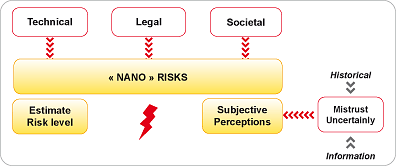
The gap between the level of risk taken into account and the subjective perceptions is maintained by three types of factors.
Three types of motivations tend to consider the potential "nano" risk as likely to be taken into account specifically:
- technical Motivation: for the same "quantity" of the same substance in macro, micro, or nanoform, the reactivity (toxicity) or physical properties (conductivity, magnetism, etc.) are very different. In addition, the parameters and references that characterize the exposure and the toxicity are still under discussion,
- legal Motivation: existing regulations on hygiene and safety (chemical risk or ATEX for example) are not often applied, but today it is the employer's responsibility to preserve the health:precaution and right to health,
- social Motivation: the evolution of risk perception requires beforehand the start of a social dialogue. Only a strategy based on examples and transparency, combined with a pedagogical approach will help to restore confidence.


